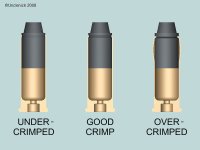TruthTellers
New member
1. Can I load less powder than the suggested starting charge?
I like to stay within published data, but for low weight bullets, I like a really light load. Take for instance .32 H&R Mag. I'm testing out light loads for lowest velocity possible. Yes, I know .32 S&W Long will accomplish that, but in the very near future I'm getting the Henry .327 lever action and I've heard that .32 H&R runs fine in the lever gun, .32 S&W Long may not.
2. Case bulges/buckling during reloading
I've noticed that when I load brand new, never fired brass that the cases are being distorted more than fire formed brass. Is this normal? I have shot some of my handloads with slightly distorted cases before and had no issues, but those that are very noticeable I toss.
3. Do I have to strictly abide to OAL in published handbooks?
So I have some 75 grain bullets that I'm loading in .32 H&R and my Lyman 50th manual says 1.350" OAL, but if I were to load it to that length, a large amount of the bullet would be sticking out and I wouldn't be able to crimp on the crimp groove.
In the past I've seated the bullet to the crimp groove and that makes the OAL under what is called out for. Again, not had an issue doing this, but I just want to ask.
I like to stay within published data, but for low weight bullets, I like a really light load. Take for instance .32 H&R Mag. I'm testing out light loads for lowest velocity possible. Yes, I know .32 S&W Long will accomplish that, but in the very near future I'm getting the Henry .327 lever action and I've heard that .32 H&R runs fine in the lever gun, .32 S&W Long may not.
2. Case bulges/buckling during reloading
I've noticed that when I load brand new, never fired brass that the cases are being distorted more than fire formed brass. Is this normal? I have shot some of my handloads with slightly distorted cases before and had no issues, but those that are very noticeable I toss.
3. Do I have to strictly abide to OAL in published handbooks?
So I have some 75 grain bullets that I'm loading in .32 H&R and my Lyman 50th manual says 1.350" OAL, but if I were to load it to that length, a large amount of the bullet would be sticking out and I wouldn't be able to crimp on the crimp groove.
In the past I've seated the bullet to the crimp groove and that makes the OAL under what is called out for. Again, not had an issue doing this, but I just want to ask.

